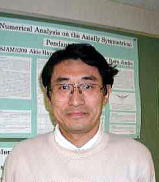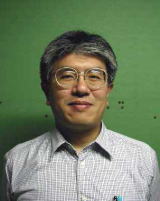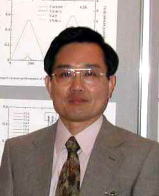
[Professor, Ph.D.] Graduated from Department of Metallurgical Engineering, School of
Engineering, Tohoku University, Japan
Chancellor of Tokai University, President of Tokai University Educational System (TES)
仭Specialty: Electromagnetic materials
仭Research Subjects: 1. Electric and magnetic properties, 2. Research on the technology
and the modern civilization
仭Important Publications: "Chromation treatment of Zinc thin films", "Future conversion", "
Research on abrasion resistant materials"
仭Important Scientific Memberships: Japanese Institute of Metals
仭Research Content: As the development in the field of electro-communication rapidly
progresses in recent years, the development of various materials became the base of
research. Especially, research related to the contact materials for electro-communication
and semiconductors, the utilization of research results of magnetic materials are studied.
Also, the development of the new contact point alloy, and experimentally based proof of the
frictional theory of the solid metals are studied. In this laboratory, development of abrasion
resistant point contact materials and their technology transfer have been realized.
Recently, research has started whether to promote constructions in the present civilization
by considering the needs of human beings and the problems of preserving the earth
environment.

Yoshiaki MATSUMAE
[Professor, Ph.D.] Graduated from Department of Applied Physics, School of Engineering, Tokai University, Japan
Vice Chancellor of Tokai University, Dean of School of Engineering, Tokai University,
Director of Tokai University Research and Information Center (TRIC)
仭Specialty: Semi-conducting material
仭 Research theme: Materials used for the next generation of automobiles, especially electric automobiles
仭 Main publication: 乬Electronic devices based on polycrystal diamond thin films乭
仭 Member of academic societies: Japan society of Applied Physics (JSAP), Remote sensing Society of Japan (RSSJ), Japan Society of Photogrammetry and Remote Sensing (JSPRS).
仭 Research contents: Research concerning materials for the next generation of automobiles, in particular focusing on next generation乫s clean energy and clean technology photovoltaic cells and electric automobile etc. is developed.
丂This research focuses on materials for use in clean energy and clean technology. Fundamental research regarding materials for electric batteries for electric automobiles is especially emphasized. Students, who want to specialize in research of electric and electronic engineering materials, are welcomed.

[Professor, Ph.D.] Graduated from Department of Metallurgical Engineering, Graduate
School of Engineering, The University of Tokyo, Japan
仭Specialty: Materials refinement science
仭Research Subjects: Mmaterials refinement, Materials recycling by separation
仭Important Publications: "Computer Aided Interfacial Measurements", ISIJ International丄
Vol. 32, No.1, 1992, "Raw materials and matter", Iron & Steel Society of AIME
仭Important Scientific Memberships: Japanese Iron and Steel Organization, Japanese
Institute of Metals, Japanese resources and materials society, Iron & Steel Society of AIME
仭Research Content: Compared to materials produced on earth, for materials produced
under the condition of zero less gravity, different properties and processing behavior are
expected. Experiments in this laboratory which lead in their last stage to space shuttle or
space station construction, as well as basic research under microgravity conditions for
developing and producing various materials are performed, in particular the separation,
mixing and forming process of liquid metals or melts at high temperatures from the
viewpoint of saving recourses and energy is inquired.
仭Laboratory Homepage URL丗

[Professor, Ph.D.] Graduated from Department of Metallurgical Engineering, Graduate
School of Engineering, Tohoku University, Japan
仭Specialty: Materials for aerospace and advanced science, Theory of phase transformation, Amorphous materials, Intelligent materials, Superconductors, Mover materials, Materials processing
仭Research Subjects: 1: Reliability technology for aerospace materials. 2: Mover materials driven by magnetostriction, electrostriction, shape memory, hydrogen storage and superconductor. 3: Strengthening and mist resistance of thin glasses applied to medical endoscope and liquid-crystal TV. 4: New high torque momentum hybrid magnetic motor for motorbikes. 5: Basic materials research for automobile.
仭Important Publications : Physical Review B丗1: Solid-Liquid interfacial energy of Ni40Pd40P20 alloy glass, 34 (1986) 1792, 2: Effect of peening on structure and volume in a liquid-quenched Pd0.835Si0.165 glass, 37 (1988) 2855, 3: Compressive stress induced Tc increase of the low Tc Bi1.6Pb0.4Sr2Ca2Cu3Ox phase, 41 (1990)6520, 4: Recovery of YBa2Cu3O7-y etched by helium ions, 46 (1992) 454).
仭Important Scientific Memberships: SAS, MRS, SAMPE, Japanese Institute of Metals, Japan Applied Physics Society, Japanese Cast society, Japanese society for Heat treatment
仭Research Content: Based on the physics and chemistry, materials (metals, ceramics, polymer and composites) applied to aerospace and related advanced science, which are automobile, IT, robots and biomedical technology, have been developed. By efforts of researches for 30 years, current research activities (2004-06) is as follows: [Journal: 47/3years, Proceedings: 47/3years, Prize;3/3years, Key note lectures: 3/3years, Invited lectures: 12/3years, News paper appearance: 6/3years]. In addition, the number of papers per year of J.Jpn. Institute of Metal;s (I.F.=0.5) is the Top of the university research groups for five years from 2006 to 2008 <11(04), 15(05), 13(06), 6 (07) & 13 (08)>. In addition, the current ranking of university patent number, which strongly contributes to industrial research, is also 9th of university research groups-2006 in Japan.
仭Labaratory Homepage URL丗 http://pubweb.cc.u-tokai.ac.jp/am026429/

[Chairman & Professor, Ph.D.] Graduated from Department of Materials Science &
Engineering, Graduate School of Engineering, Toyota Technological Institute, Japan
仭Specialty: Ceramics processing, materials reaction engineering
仭Research subjects: 1. Prototype manufacturing of ceramics, 2. Materials reaction
engineering based on reaction mechanism, 3. Characterization of ceramic properties
仭Important publications:丂"Introduction to ceramics"乮single author, Baifukan, 2002乯, "
Ceramics processing handbook 乮2nd Edition乯"乮various authors丄Gihodo Publisher, 2002乯, "
Chemistry of ceramics"乮co-author, Maruzen, 2005乯
仭Important scientific memberships: Ceramic Society of Japan, Japan Powder and Powder
Metallurgy, Materials Research Society
仭Research Content: Various ceramic materials exist, each with excellent properties, such
as high hardness, heat-resistance, high dielectric constant, electric conductivity,
piezoelectricity, or safe bio-compatibility, respectively. New ceramics with new properties
are subject of research and development. For the research of ultra-high temperature
environment ceramics a research grant application was successfully accepted by the
ministry of science and education. Also, prototype production of the next generation of
ceramics for space applications and renewable energy sources, namely novel non-oxidic
ceramic prototypes based on Boride, a high temperature oxidation process using the
reaction mechanism and high temperature characterization are research themes. At a
research project on bioceramics based on a sabbatical in University of Cambridge
University, UK, excellent conformity with the living body and high mechanical properties
were achieved. Furthermore, research on functional ceramics and their applications with the
feasibility check for possible industrialization, for example in fluorescence, non-electrostatic
charging, absorption and so on, is also one of studied themes.
仭Laboratry Homepage URL丗 http://pubweb.cc.u-tokai.ac.jp/jmatsu/

[Professor, Ph.D.] Graduated from Department of Metallurgical Engineering,
Graduate School of Enginnering, Tokai University, Japan
仭Specialty: Joining processing, Materials properties
仭Research Subjects: 1. research on new lead-free soldering, 2. commercially pure (CP)
titanium joining with other metallic alloys, 3. Ni-based filler metals for wide clearance brazing
of stainless steel, 4. Zirconia ceramics color change phenomena, 5. Basic research on new
high-functional joining methods, 6. Research on spot welding
仭Important Publications: "Brazing properties of Ni-based filler metals for of Ni-based alloys
or steel"
仭Important Scientific Memberships: Japanese Institute of Metals, American Welding
Society, Japan Welding Society, Japanese Institute of Light Metals, Japan Society for
Technology of Plasticity
仭Research Content: In this laboratory, research on high-functional joining processing
technology is performed as introduced in the following examples. In the field of aviation and
astronautics, for the realization of the design of high-performance engines the development
of new materials and the establishment of their processing technology are indispensably
necessary. Even when expressing processing technology in just one word, there are so many
processing methods, like cutting, bending, extrusion, etc. and joining is one of the important
processing technologies. In this laboratory, basic research on joining technology of heat-
resistant materials for possible aerospace applications is performed. Furthermore, basic
research on often used solder materials in the field of electronics is performed. Lead, which
is often used until now in soldering alloys, is known a non-environmental-friendly material. In
our laboratory basic research on new lead-free multi-functional soldering is also performed.
仭Laboratory Homepage URL丗 http://pubweb.cc.u-tokai.ac.jp/ceramics/
------------------------------------------------------------------------------

[Professor, Ph.D.] Graduated from from Department of Metallurgical Engineering, Graduate
School of Engineering, Tohoku University, Japan
仭Specialty: Research on superconductor materials and their applications
仭Research Subjects: 1) High-Temperature superconducting (HTSC) materials for use as current leads or electric power cables.2) Improvement of the critical current of MgB2 materials for use in liquid hydrogen technology.
仭Important Publications: 1. Y. Yamada, M. Nakatsuka, A. Nitta, K. Tachikawa and H. Kumakura, Superconducting Properties and Structure of In-situ MgB2 Tapes with SiC and TiC Addition Prepared by Hot Pressing, IEEE Transactions on Applied Superconductivity, 17 (2007) 2911-2914.
2. Y. Yamada, K. Tachikawa et.al. Transport Performance and Structures of Bi2212 Superconductors Prepared by Diffusion Process (in Japanese), Japanese Institute of Metals, 71 (2007) 972-976.
仭Important Scientific Memberships: Japanese Institute of Metals, Japan Institute of Electric Engineers, Cryogenic Association of Japan, Japan Welding Society
仭Research content: Transportation with linear motor cars, electric power storage and electricity transmission, magnetic resonance imaging (MRI) in medicine, computer information and communication science are some of the wide fields, in which research of the superconductors is being expected to play an important role as future key technology, especially after the recent discovery of ceramics with high critical field and high critical temperature (Tc). Research activities focused on the relations between processing and fundamental properties of the high-Tc superconducting ceramics have greatly increased, compared to the conventional metallic superconductors. In other words, the difficult; processing for ceramics for bulk, as well as for wires, has been performed and the relationship between micro-structure, composition and superconducting properties and their influence are evaluated aiming for possible applications. Especially the critical electric current density, that is the value of maximum electric current, which can flow through the unit area of the superconductor at zero electric resistance, is considered as the key factor for realization devices. Recently JR Central announced that the linear motor car connection in about 40 min between Tokyo and Nagoya will be realized in 2025. This will be worldwide the first large-scale application of zero-resistance electric wires and will be a considerable contribution to save the environment.
仭Laboratory Homepage URL丗

[Associate Professor] Graduated from Department of Electric Engineering, School of
Engineering, Tokai University, Japan
仭Specialty: Semiconductor engineering
仭Research Subjects: 1. Fabrication and characterization of Nano-structured
semiconductors produced by cluster beam method, 2. Fabrication and characterization of
semiconductor thin films produced by ion beam method, 3. Fabrication and characterization
of semiconductor thin films produced by ion beam sputter method,
仭Important Publications丗 "Tetragonal germanium films deposited by the cluster-beam
evaporation technique"乮Appl. Phys. Lett., 66乮1995乯3176-3178乯
仭Important Scientific Memberships: Japanese Society of Applied Physics, Institute of
Electric Engineers in Japan, Materials Research Society
仭Research Content: Research on semiconductor thin film production, physical and
chemical properties measurement, device manufacturing is performed. For the thin film
formation growth cluster beam, ion beam assistant, and ion beam sputtering methods are
used. At the cluster beam method, Ge or FeSi2 nano-particles semi-conducting thin film
are grown and new light emitting devices based on quantum-size effects are produced. With
the ion beam assistant method effects of vapor deposition and simultaneous irradiation of
various ions are studied, and with inactive ions the thin film structure is controlled and with
active ions the reactivity is controlled. In such way Nitrogen semiconducting thin films are
produced. Research with the ion beam sputtering method by simultaneously sputtering of
insulators and metals metallic thin films with nano-particles are grown and used for gas
sensors and other applications.
仭Laboratory Homepage URL丗
------------------------------------------------------------------------------

[Associate Professo, Ph.D.] Graduated from Department of Metal Science, University
Stuttgart, Germany
仭Specialty: Materials development, Materials physics
仭Research Subjects: 1. Development of thermoelectric materials, 2. Interface
characterization of diffusion bonded metal compounds, 3. Development of perovskite based
functional ceramics
仭Important Publications: 乽Increase of effective mass of Nb-doped SrTiO3 for
thermoelectric applications乿乮arxiv/condmat-0510013乯, 乽Improvement of interfaces at nano
-ceramics乿乮J. Cer. Proc. Res., 4 (2003) 10, 5(2004) 30乯丄乽Mobile misfit dislocations at TiAl/
Ti3Al Interfaces乿乮Acta Mat., 41(1993) 1791乯
仭Important Scientific memberships: Japanese Institute of Metals (JIM), Japan Physical
society (JPS), German Physical Society (DPG), German Material Society (DGM)
仭Research Content: 1. For future energy support, thermoelectric materials, which convert
waste heat into useful electric energy will play an important role. The most important
factors for high efficiency of semiconductors or semi-metal alloys are carrier concentration
and the effective mass. According to calculations based on this principle, the promising
intermetallic phases with Half-Heusler crystal structure are manufactured and
characterized. 2. For application as in robots, strength and light-weight materials are
important. The composition, microstructure, dislocation, and other defects on atomic level
have a large influence on the interface strength. The interface structure is characterized by
transmission electron microscopy (TEM).3. Superlattices based on the perovskite crystal
structure show extraordinary functional properties due to their interface structure, such as
piezoelectric, dielectric, semiconducting and superconduting properties and, when
understanding the underlying principle, even better materials can be manufactures.
仭Laboratory Homepage URL丗 http://www.angelfire.com/wi/wunder/jpleb2.html

[Junior Associate Professor, Ph.D.] Graduated from Department of Metallurgical
Engineering, Graduate School of Enginnering, Tokai University, Japan
仭Specialty: Nano-materials Measurement science
仭Research Subjects: 1. Transmission-Electron-Microscopy (TEM), 2. Nano-Manipulation, 3.
Carbon Nanotubes (CNT), 4. Composite materials, 5. Properties of naomaterials
仭Important Publications: Many
仭Important Scientific Memberships: Japan Applied Physics Society, Japanese Society of
Microscopy
仭Research Content: Research using Transmission-Electron-Microscopy (TEM) and Atomic
Force Microscopy (AFM) is performed and the nanostructure and their related properties
of various materials, like metals, ceramics, carbon-based materials are characterized and
measured for the purpose of materials development with revelation of novel physical
properties and new materials. Especially, during in-situ TEM observations extreme
conditions, such as ultra-high electric field and ultra-high temperature are realized locally
and nano-structure is characterized and various properties are measured dynamically.
Nanostructure characterization is essential for advanced materials research. Using the
information of in-situ observation and measurements at different TEM machines, intuitive
understanding of structure-properties-relationship will become possible according to the
experience 乬Seeing is believing乭. Materials research on nano-scale leads to new discoveries
and the hidden secrets of unexpected new materials will be revealed. Recently, with a new
experimental in-situ TEM method, the nano-probe operation technique, challenging
measurements of mechanical properties of Carbon nanotubes are possible.
仭Laboratory Homepage URL丗
|
Copyright (c) Department of Materials Science, Tokai University. All rights reserved.
